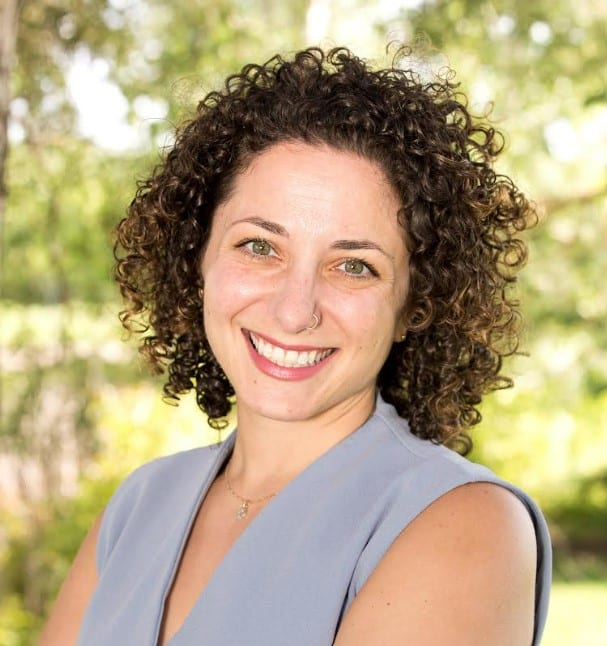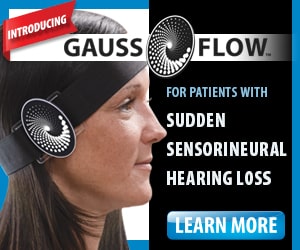The Audible Contrast Threshold (ACT™) test is the quickest method to accurately measure a person’s ability to hear in noisy environments. Developed by the Interacoustics Research Unit, ACT™ uses a non-linguistic, contrasting stimulus to provide a personalized testing experience. The results offer objective data that directly guides hearing aid fitting by predicting aided speech-in-noise performance.
In this session, originally part of the 2024 Future of Hearing Healthcare conference, Dr. Ashley Hughes will explain the research behind the ACT™ test, demonstrate how to perform it, and interpret the results. Additionally, she will discuss how these results can inform hearing aid recommendations and setting adjustments.
For those interested, a Q&A on the ACT™ test can be viewed here
Full Episode Transcript
Thank you for joining for
this presentation.
The ACT test unveiled a Game
changer for precise hearing
aid amplification in
noisy environments.
My name is Ashley Hughes and I’m
an audiologist at Interacoustics
US.
I began working at
Interacoustics just over
four years ago,
but have been practicing in a
variety of settings for
over ten years.
Prior to joining
Interacoustics,
I first worked clinically,
then I worked as a research
audiologist for a hearing aid
manufacturer and then I joined
Interacoustics in 2020.
In my current role at
Interacoustics, I provide support,
education,
and training on all things
audiometry, impedance OAEs,
hearing aid fitting,
verification, and telehealth.
And of course,
with that now comes support and
education on ACT more
to come on that.
As mentioned,
today’s focus will be
on the new ACT test,
which stands for Audible
Contrast Threshold developed
by Interacoustics.
During today’s session,
you’ll learn the requirements
and benefits to both the patient
and clinician of incorporating
and using the ACT test,
how to prepare for and complete
the ACT test, again,
both from the patient
perspective and the provider
perspective,
and finally,
how to interpret and utilize the
ACT value to improve patient
outcomes and provide value to
both the patient and
the provider.
To learn this,
we’ll also spend a fair amount
of time today reviewing the
research that led to the
development of actual
on this slide you can see a
brief overview of our
agenda for today.
Well start with discussing
why ACT was developed.
Audiometry is an important
clinical tool,
but there are aspects of hearing
that the pure tone audiogram
doesn’t cover.
Think about what information we
don’t get when performing
pure tone audiometry.
We get some information from
pure tone. Audiometry,
but not the whole picture.
The audiogram doesn’t tell us how
the patient will perform
in the real world.
The ability to hear pure tones
in quiet does not reflect the
typical demands that everyday
conversational situations
impose.
In using only.
Pure tone audiometry to fit
hearing aids is limited in the
guidance we then have for
advanced hearing aid
feature settings.
Finally,
as many studies have shown,
we know already that pure tone
audiometry is a poor predictor
of intelligibility.
Speech audiometry is something
that clinicians perform at times
to supplement audiometry.
Performing these tests provides
the clinician with
more information,
and we can see and understand
some of the reasons why speech
audiometry is beneficial.
It certainly has its place,
and there are lots of studies to
suggest speech in noise tests
specifically can help supplement
the patient rehabilitation
process.
Additionally,
speech audiometry provides
relatable material
for the patient.
It can help guide hearing
aid management,
it can be used during the
counseling process and more.
Now we can all agree why speech
testing can be very beneficial,
and there are plenty of articles
suggesting why it
should be done,
but what exactly prevents some
clinicians from doing it?
We certainly know that in real
life situations it can be
difficult to include speech
audiometry within our
appointments,
despite the advantages
of including it.
Some of these obstacles
are time,
access to testing materials,
objective and clear starting
points for clear audibility for
the patient room setup,
and more.
So,
we know that the audiogram
is vital,
it’s what’s mandatory for
hearing aid prescription
targets.
But we get no information about
speech and noise abilities from
the pure tone audiogram.
Speech audiometry is a great
additional to any consultation,
but does have its limitations
in some cases,
and not everyone is doing
it in any case.
So what marries the two?
What can give us accurate
diagnostic information that
takes us beyond the audiogram
that’s unique to each patient
and can address the number one
concern reported by patients
with hearing loss?
Hearing and noise.
And this is where act
comes into play.
On the next few slides,
we’re going to walk through the
typical patient workflow.
Based on today’s standards,
we’re typically starting
with an audiogram
then moving on to advanced
diagnostic tests when needed,
such as the TEN test.
Speech in quiet testing is
often performed SRT, Word rec,
MCl, UCL, etcetera.
And at times we’re moving on to
speech in noise tests like the
quicksand, ANL things like that.
These are great indicators for
hearing aid acceptance,
but they’re not completely
objective tests and can’t be
used automatically to adjust
advanced features and
hearing aids.
And after that point, we’re.
Course,
moving on to the hearing aid
fitting when appropriate.
So with the patient in mind,
a gold standard consultation
could look like incomes act,
the accurate predictor of aided
speech and noise performance,
independent of language and
easy to administer.
The purpose of this workflow is
to show what could be possible
you would still perform
audiometry.
It’s a baseline requirement
for ACT.
ACT isn’t replacing any part of
a clinician’s existing workflow
if they don’t want it to,
but it can be used as a
replacement for other speech
and noise tests.
It’s a fast test designed to be
used alongside your audiogram in
order to make a comprehensive
and customized fitting
for your patient.
Lets take a look back at the
research that has led to the
creation of ACT and the pathway
from research to diagnostic
implementation.
To best understand ACT,
were going to take a journey
from where it started
to where we are now.
Well go through everything
from the history of act,
who the brains are behind
the invention,
what is the background evidence
behind act that makes it
accurate and reliable?
And how did we create a user
friendly diagnostic
implementation so it can be
added to your existing workflow?
So why ACT and why now?
Because the only diagnostic
measurement we currently use to
program hearing aids
is the audiogram,
which is still extremely
valuable.
But as we’ve already discussed,
hearing loss is so much more
than the audiogram.
There has been an ongoing search
for diagnostic tests that take
us to the next level beyond
the audiogram,
but no one was able to
confidently and successfully
create this. Yet.
An act is about to change this.
If we think of the audiogram as
measuring the quantity
of the hearing,
act measures the quality
of the hearing.
We still have our audiogram
and real ear measurements,
of course,
that ensure the hearing aids are
programmed appropriately
for the hearing loss,
acoustic parameters of the
patient’s ears, and more.
But now we also have ACT,
another tool in our toolkit that
helps guide the programming of
advanced help and noise features
in hearing aids.
These two combined provide you
with the tools you need to get
a complete diagnosis of your
patient’s hearing and a more
objective and customized
fitting.
This has been a giant
undertaking and because of this,
I want to make sure to give
credit where it’s due.
To the collaborative team that
was involved in the
creation of ACT,
we have had interacoustics
research unit heading up seven
years of research.
The journey also involved inner
acoustics for diagnostic
implementation.
Eriklsholm research Center.
And CARR,
the Center for Applied
Audiology Research.
Together,
we developed ACT and transformed
it into a unique automatic
prescription.
More to come on this,
but for now,
we’ll move on to the research.
So where did it all begin?
It began in the 2010s,
when research saw a strong
correlation between a test of
something similar to ACT and
speech in noise measures.
This early version of ACT,
as we now call it,
is known as spectrotemporal
modulation, or STM,
and it’s a psychoacoustic
measure.
STM is essentially an
unmodulated sound with a
modulated sound imposed
on top of it.
As an example of what STM is,
we can see on the left a
spectrogram of a single
sentence.
As you know,
this shows characteristic
patterns across frequency
and time.
These patterns are the same as
in an early ACT or STM stimulus
shown on the right.
Modulations are imposed
onto a noise signal,
so you get a similar pattern as
the speech spectrogram
on the left,
but in a more controlled
and structured fashion.
Let’s hear some sound
examples of this.
First,
you’re going to hear
the ACT stimulus.
Next you’ll hear the reference
noise or the steady noise.
And finally,
you’ll hear the ACT stimulus
imposed on top of the
steady noise.
If you’re good at act,
you can detect tiny modulations,
which in essence means you’re
good at detecting the important
speech cues when embedded
in background noise.
By manipulating the depth of the
modulations and getting patients
to detect these modulations,
we can obtain a threshold or an
act value from which we can
infer how good someone will be
at picking out the speech
cues and noise.
However,
there were problems with this
early version of ACT.
A body of literature on STM was
studied and there was interest
gained in this in 2013,
where they were showing
correlations between early
versions of ACT against other
speech in noise measures.
The results from this
more controlled,
carefully recruited group
of test subjects showed
correlations were very high with
beyond the audiogram measures.
In 2016, a subsequent study,
our early act test,
was taken through a large
study in Sweden,
but one third of the population
couldn’t do the test.
They couldn’t hear
the modulations,
which was very frustrating
for that one third that failed.
They had to modify the test
paradigm so that they could
get a measurement,
which is where the data points
come from on the slide
at this point,
IRU really wanted to unleash the
potential of this test and make
it clinically viable as act
as we know it today.
So what modifications did IRU
have to make to this
early version of.
STM to make it clinically
viable.
As we’ve said,
earlier versions of
spectrotemporal modulation were
not easy tests to administer.
So let’s take a closer look of
what we had to do to unleash
its full potential.
The first change was to ensure
that the stimulus was
clearly audible,
to ensure that patients could
actually do the test.
In previous tests,
we talked about how there was a
ceiling effect where essentially
one third of the participants
couldn’t complete the test.
The first modification was to
add ear and frequency specific
compensation for hearing loss.
In previous STM tests,
in order to make the
stimuli audible,
they cranked the signal up,
but IRU took a different
approach.
On the slide you can see a graph
showing gain compensation.
Here’s a closer up image of that
graph as we go through it.
In the green line you can see
hearing thresholds of normal
hearing people.
In the black line you can see
the ACT stimulus played to
someone as if they have
normal hearing.
You can see that across
the frequency range,
it’s aligned with the natural
speech levels and everything
is super threshold.
Now,
if we take a look
at the red line,
we have an audiogram of an
individual with hearing loss.
If we were to present the black
stimulus to people with an
audiogram that looks
like a red line,
they wouldn’t hear the
entire stimulus.
The entire stimulus is
not super threshold.
And now you can see what Iru did
differently in the pink bars,
increasing the necessary
frequencies by 15 decibels
sensation level
to make them clearly audible and
therefore following the shape
of the audiogram,
IRU ensured that the stimulus
was clearly audible to fight
the sailing effect,
particularly in older
individuals due to cognition
etcetera.
They also changed the test
paradigm to a three alternative
forest choice paradigm in order
to make the differentiation
between stimuli easier.
In this test paradigm,
one sound of the three presented
was different and the test
subject was required to pick the
odd one out rather than
in previous studies,
they had to explain the
difference between two
presented stimuli.
During this iteration,
the modulation times were also
increased from 0.5 seconds
to 1 second.
Finally,
during these evaluations,
IRU decided to go with a
binaural stimulation instead
of a monorail stimulation,
increasing the ease and accuracy
of the test as well as improving
the correspondence with real
world speech and noise
listening situations.
Next,
they had to adjust the degree of
spectral modulation and the
bandwidth of the stimulus.
To do this,
the researchers needed to look
at other speech and
noise measures.
In collaboration with Eriksholm,
IRU set up a test environment
that imitated a real world
listening environment,
but using loudspeakers this
study looked at actual.
In relation to speech and noise
measures, in this case,
the hint.
The hint was used since it can
be set up in an ecologically
valid fashion against simulating
real world listening situations.
They found a high correlation
between act values
and hint scores,
and all study participants were
able to produce a threshold,
resolving the ceiling effect and
reinforcing the relationship
between act and speech and
noise performance.
To summarize,
what IRU completed
until this point,
they compensated for audibility,
ensuring super threshold
presentation.
They changed the test paradigm
to a three alternative
fours choice.
They extended the length
of the modulations,
they went from monaural to
a binaural presentation.
They ensured that the task and
stimuli parameters provide
reliable results across
the board,
and they ensured that the test
has a high correlation to speech
and noise testing performed in
an ecologically valid fashion.
At this point,
we knew that ACT works,
and we wanted to create a
clinically viable tool.
In order to do this,
IRU conducted further research
to ensure the test
time was quick.
There was no need for
extra hardware.
It used a familiar procedure
that audiologists are used to,
and the value it produces takes
into account the best available
data points for a more precise
threshold determination.
So, after all this research,
what makes ACT so special?
We have a foundation for
a better first fit.
The act value has a strong
correlation to predicted aided
performance in noisy
environments,
the most common concern reported
by patients with hearing loss.
This value can help guide you on
how to adjust advanced features
on the hearing aids.
At the first fitting for
select hearing aids,
the ACT value can be input into
the hearing aid manufacturer
software,
and the adaptive features of
that hearing aid can be
automatically adjusted.
It is the first ever language
independent diagnostic test of
speech in noise ability.
It’s conducted in a very similar
way to pure tone audiometry
using the modified Houston
Westlake bracketing approach,
but with two in four decibels
step sizes instead
of five and ten,
making it an easy test to
perform for both the patient
and clinician.
Other speech in noise tests can
take significantly more time
than ACT, which takes,
on average, two minutes.
And we have a novel way of
denoting the act value,
the nCL scale,
which was created in order for
us to understand how act values
compare to normal hearing
listeners.
Now let’s take a look at the act
software and how we perform it.
I’ll show you what it looks like
today using the interacoustics
Affinity compact.
This is a close up of the ACT
software screen. You can see.
The presentation numbers on the
x axis and the ACT value
in dBnCl on the y axis.
There’s a line at 25
presentations because this is
where you begin to risk
patient fatigue.
In order to avoid hitting or
going over 25 presentations,
it’s very important not to time
lock the patient during testing.
Channel one and channel two
presentation levels will be
predetermined based on the
audiogram and one channel will
be routed to each ear.
The test will always start
at 16 dB nCL,
which you can see in the top
center of the screen,
and as the nCL value decreases,
the modulation is more
difficult to detect.
On this next screen,
you can see a completed
ACT test.
When the clinician introduces
the modulation,
the software will automatically
determine if the patient
responded or not based on the
timing of the presentation
and the patient response.
A correct response will show as
a black filled in circle and
an outline circle is a miss
in the top right hand corner.
You’ll be able to see
false alarms.
Every time the patient
correctly responds,
the clinician will make it four
decibels more difficult
or two steps,
and when the patient misses it,
the clinician will make it two
decibels easier or one step
again following the modified
Houston Westlake bracketing
approach,
but using two and four decibels,
step sizes instead
of five and ten.
Note that the clinician is not
adjusting the intensity of
channels one or two,
but rather the difference
between the modulated signal
and the base noise.
When the patient responds
correctly at the same intensity
three of five times on
an ascending trial,
the software will automatically
stop you and provide you
with the ACT value.
Once you have the ACT value,
you can click on guidance to see
the ACT value ranges
and fitting advice.
We’ll take a look at those
in just a moment.
With all this information
on ACT,
we’ll spend a bit of time
talking about how you can go
about using the results.
Generally speaking,
the greater the ACT value,
the more help one will need from
the hearing aids in noise.
You can use the ACT value
in one of two ways.
If the hearing aid manufacturer
supports it,
you can use an automatic
function and the value of the
ACT will be transferred into the
hearing aid manufacturer
software to determine the level
that the adaptive feature
should be set at.
These changes can be made again
automatically through the
hearing aid manufacturer
software.
However, in some cases,
if that isn’t an option,
you can use the guidance
that we provide.
You can see from the scale that
the act value will fall into one
of four categories ranging
from normal to severe.
The lower the number,
the smaller of a modulation.
The patient was able to detect
again if somebody.
If someone has a lower
ACT value,
that means they’re able to
detect even smaller modulations.
So the recommendation for these
patients is to pull back on
those advanced help and
noise features.
Those patients are doing just
fine at detecting speech in
noise without extra help.
On the other hand,
with a higher ACT value,
you’ll want to do the opposite
and increase those advanced
features,
perhaps recommend some
additional accessories for that
patient from the very beginning.
If we think about fittings
as they exist today,
two patients with the same
audiogram, same age, etcetera,
would likely leave an office
with the same help in
noise settings.
With the introduction of ACT,
we can now be confident on when
we want to pull down on some of
those advanced adaptive features
and perhaps crank these features
up for some patients,
meaning two people of the same
age with the same audiogram will
leave the clinic with two
different and customized fitting
setups from the very beginning,
which in turn will improve
the first fitting.
In summary, we know that ACT,
or the audible contrast
threshold test,
is a clinically viable test of
spectrotemporal modulation
detection.
It uses the audiogram to
individually shape and customize
the stimulus to ensure full
audibility across the
frequency range.
ACT as a measure of an
individual’s aided predicted
speech in noise performance
using hearing aids in realistic
conditions.
It is a fast and simple test.
It takes, on average,
two minutes.
It can be done immediately
after the audiogram,
and it is a language
independent test,
meaning it can be done on every
patient irrespective of their
language background.
If a patient is able to follow
pure tone audiometry
instructions,
they’ll be able to follow
ACT instructions.
Expected outcomes when using
act are to provide you with
confidence when you’re
prescribing or adjusting those
advanced help and noise features
on hearing aids.
Improved patient outcomes
in noisy situations,
reduced follow up visits,
reduced in the drawer
hearing aids.
And we’re very excited about the
more research that we’ll be able
to share as it becomes available
on the ACT test.
Thank you for taking the
time to join today.
If you’re interested in learning
more about act and you’re
in the United states,
please contact your local
e3 Diagnostics sales
representative.
For those outside the US,
please reach out to
Interacoustic directly at
as shown on the slide.
Thank you.
Be sure to subscribe to the TWIH YouTube channel for the latest episodes each week, and follow This Week in Hearing on LinkedIn and on X (formerly Twitter).
Prefer to listen on the go? Tune into the TWIH Podcast on your favorite podcast streaming service, including Apple, Spotify, Google and more.
About the Presenter




 Ashley Hughes, Au.D. works for Interacoustics US, serving as the main point of contact for audiometry, impedance, OAE, hearing aid fitting, and telehealth solutions. Prior to joining Interacoustics, she worked as a clinical and research audiologist, and has been an invited speaker at state and national conferences, authoring multiple published articles and posters on various topics. She is actively involved in the American Academy of Audiology and the Minnesota Academy of Audiology.
Ashley Hughes, Au.D. works for Interacoustics US, serving as the main point of contact for audiometry, impedance, OAE, hearing aid fitting, and telehealth solutions. Prior to joining Interacoustics, she worked as a clinical and research audiologist, and has been an invited speaker at state and national conferences, authoring multiple published articles and posters on various topics. She is actively involved in the American Academy of Audiology and the Minnesota Academy of Audiology.


